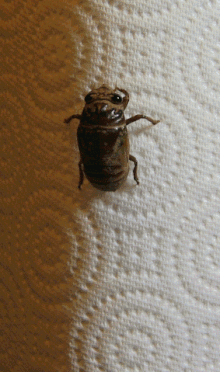Right now if you go outside, there is an incessant hum in the surrounding trees. It is the sound of cicadas, or locusts, as we call them. The pitch is constant and ever-present. These things are everywhere flying around and making noise, especially as the sun starts to go down. After mating the female lays eggs in the bark of trees. Once they hatch, the nymphs drop to the ground and tunnel where they'll live for most of their lives, eating the sap from roots for sustenance. Here are three of their tunnels in just about a one square foot area.
 |
| Cicada burrows |
Here's the crazy part. Their life cycle, according to Wikipedia, can range from 2 to 5 years and they eat the sap from roots. Amazingly, the North American genus' life cycle ranges from 13 - 17 years! In the nymph's final stage, they'll emerge from the burrow and molt, shedding their shell (or exoskeleton). You'll see these shells all over the place on fence posts, trees, etc. Here is a cicada exoskeleton on one of our orange trees.
 |
| Just a shell is left behind |
Here is an animated presentation from Wikipedia that shows a time lapse of the molt:
Here is a nymph in its final stage that was crawling along the concrete in the garage.
 |
| Looking for a place to molt |
Here is an adult that has just exited the shell on the fence post by the gate to our pasture.
 |
| Free at Last! |
The locust will hang there for a while while its wings dry, and then it will fly off, leaving the shell behind. I read where in some cultures, these locusts, especially the females, are eaten. No thank you. I'd have to be really, really hungry!
 |
| Just hanging out |
Locusts do happen to have a vicious predator: The Locust Killer Wasp. These bad boys are really a frightful thing to watch. According to
This Link it explains that cicada killer wasps grow to an inch and a half long. They are so much bigger than regular wasps, but they aren't aggressive toward people. The females dig burrows where they deposit their larvae. You can spot the burrows by all the dirt piled up by the opening.
Here's the neat part. The female cicada killers, true to their name, will hunt. They will sting a cicada and this paralyzes it. They will attack the locust in a mid air collision. Then they'll either coast down near their burrow with the cicada in tow or they'll drag it into their burrow where the larvae will feed off of. Then they'll rise to the surface and continue the cycle.
The cicada killer wasp looks pretty scary! I hate to think of what her predator might look like!!







No comments:
Post a Comment